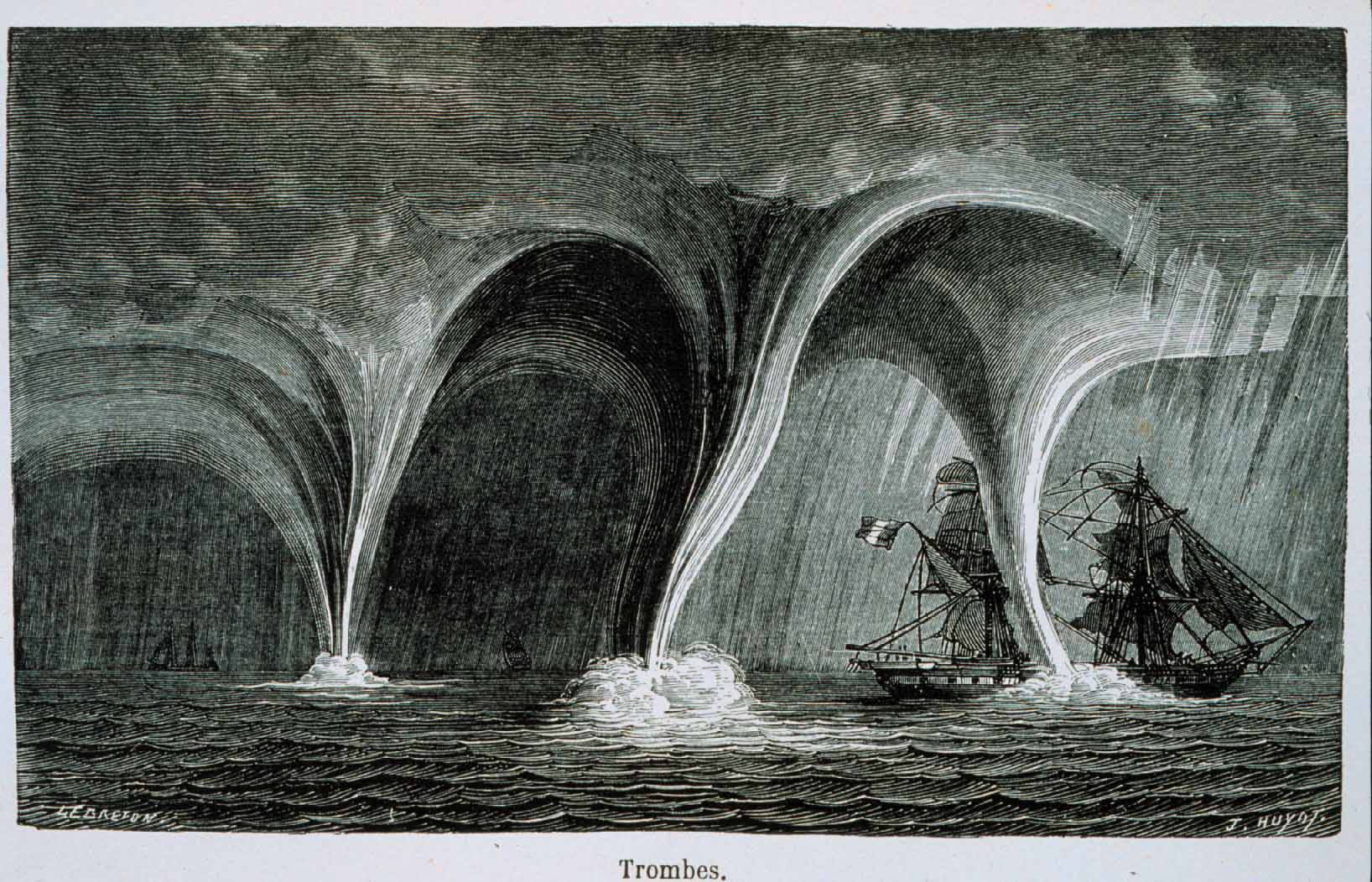
Waterspouts of old (source: Vintage Printable)
Even though many people may associate itsy bitsy spiders with waterspouts, you won’t see any spiders near the meteorological namesake. Despite their rather innocent sounding name, waterspouts can have a particularly dark side.
In Tunis harbor on the 18th November 1855, a storm cloud gave birth to a ferocious waterspout that lasted for over half an hour. James Squire witnessed and described the event in a letter to the Cambridge Chronicle (USA). According to Squire, the waterspout had the appearance “of a huge oak, a most colossal trunk supporting a majestic head”. Despite the poetic description, the waterspout wreaked devastation in the harbor, sinking four vessels and killing three sailors.
It’s not difficult to see how large waterspouts can instill fear in the eye of the beholder. They can easily conjure up thoughts of their more destructive cousin: the tornado. Videos of large waterspouts are easily found on the Internet. The video below shows a waterspout coming ashore on a hot summers day in North Carolina. The circular winds rip the beach break from the shoreline and lift and throw beach furniture in all directions.
The screams of the cameraman’s wife communicate her dissatisfaction of him still being outside. The waterspout was obviously far too close for comfort.
Florida is one of the main hot spots for waterspout formation. In the 1969 Lower Keys Project, Joseph Golden, a scientist from NOAA recorded 95 off the coast of Florida. Golden and his colleagues flew around and documented the waterspouts they came across and how they developed.
Places like Florida and Tunis share a hot maritime climate. Waterspouts form where we find strong convection over particularly warm seas. I wouldn’t expect to see one in Norway!

The cumulus congestus that bubbled up on 4th August off Norways eastern coastline (Bamle district). Can you see the waterspout?
I spent this last summer on the east coast of Norway. On the afternoon of 4th August, I walked outside admiring the beautiful cumulus congestus bubbling up on the horizon. I was surprised to see that the majestic head was in fact supported by a trunk! I watched in wonder for a few minutes and ran to get my camera. I wanted to see it closer, but it turned out that it was a small blessing to see it at the distance. I could easily capture, not just the waterspout itself, but other meteorological processes at work. It turns out that these processes could have helped the waterspout to form and remain spinning for quite some time.
In a convective cloud we have updrafts and downdrafts. The updrafts are what cause the cloud to grow. Warm air bubbles rise up from the surface. As they ascend the air bubbles get cooler. However, if the bubbles remain warmer than the surroundings then they rise further. As they cool, the water vapor inside them condenses and the cloud forms. If this process continues, the cloud droplets get bigger and become rain. When the rain starts to falls, it evaporates. As it evaporates it cools the surrounding air, and along with the drag caused by the rain itself, forces the air to descend. This cooler air is called a downdraft. When it hits the surface it can spread out like spilt milk. This is important when it comes to waterspouts. The downdraft can undercut a waterspout and destroy it (Simpson et al, 1986).
With our waterspout, the change in winds with height (or vertical wind shear) may have helped it survive. You can see from the photograph that the cloud leans over to the left. This is because of the vertical wind shear. On this day, the winds increased with height. Higher up in the atmosphere, the stronger winds pulled the cloud further and further to the left. Since the updraft was pulled in the same direction, the downdraft was kept at a safe distance from our waterspout.

My impression of how the wind shear influenced the updraft and downdraft in the cloud, and helped the waterspout survive.
The illustration shows my impression of what was happening. In 1986, Simpson and others used numerical simulations to show that waterspouts were in fact more likely to develop where there was vertical wind shear (like I witnessed) so that the downdraft didn’t under-run the updraft too early. It seems that I may have witnessed exactly what their models told them.
It’s not just in Norway that we see waterspouts in northern Europe. However, they are limited to regions where the sea surface temperatures are relatively high in the summer months. This is why we see waterspouts on Norway’s East coast but they are extremely rare to the west. They also pop up along coastlines bordering the Baltic Sea and the southern part of the North Sea (Dotzek et al., 2010; Sioutas et al, 2013).
Even though the waterspouts in Norway are unlikely to cause the havoc and devastation as the one in Tunis in 1855, they can still be a force to be reckoned with. So, if you find yourself on Norway’s eastern coast on a thunderous summers afternoon, keep an eye out across the water. You may see a trunk supporting a majestic head!







